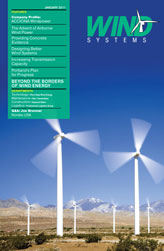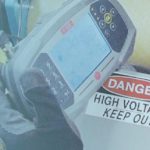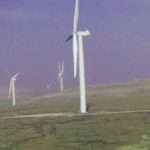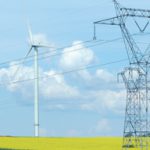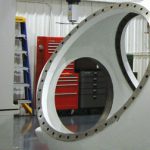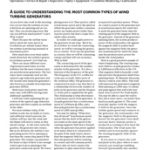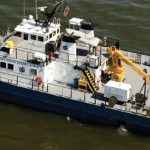Soon to rise from the fertile corn and soybean fields of central Illinois is the White Oak Wind Energy Center, developed by Chicago based Invenergy LLC. The 150-megawatt project located northwest of Bloomington, Illinois, will include 100 General Electric 1.5 megawatt wind turbines. Invenergy has reportedly negotiated power purchase agreements (PPA’s) with the Tennessee Valley Authority, a federally owned utility, to export the wind power out of state.
Plenty of Power
According to Illinois Wind Power, the electric load in Illinois is primarily served by large coal and nuclear plants that use hundreds of miles of high voltage transmission lines to deliver power to users. Wind farms can easily tie into this existing infrastructure, making wind power a valuable export commodity for rural Illinois communities. Illinois electric transmission lines are part of the PJM electric grid, a regional transmission organization that serves a market of over 50 million people in 13 states. Illinois has the strongest winds in the PJM market, which is driving a massive expansion in wind energy development. Currently over 25 existing wind energy sites are operating in Illinois, adding over 2000 mega-watts of power to the states electrical grid. Additional data show that more than 30 new wind projects are in the planning stages bringing the potential for more than 12,000 mega-watts of installed wind power capacity in the coming years. Figure 1
A typical wind farm like White Oak will have the capacity to supply power to more than 40,000 homes. Projects like these will bring thousands of new jobs, tax revenues, and other forms of economic development to the area. In recent years Chicago, with its close proximity to wind sites in the Midwest, has become the home of the wind energy industry in North America. Attracted by well-developed air, rail, and auto transportation infrastructure, several of the world’s largest wind energy companies have opened offices there and now call Chicago home. Illinois-based companies such as Siemens Winergy and Trinity Structural Towers are making Illinois a leader in wind component manufacturing. Fabrication companies and machine shops in Illinois represent a strong potential for turbine component manufacturing, along with other related wind energy components and services.
White Oak’s wind towers will stand about 262 feet high with a blade sweep area of 274 feet. The total overall height will be 397 feet. A typical foundation for this size turbine requires over 300 cubic yards of concrete. Foundation costs have become a significant proportion of the total cost for a wind farm and can impact the overall cost of energy. Figure 2 Therefore, foundation design and selection of materials, along with shorter construction times, are important economic considerations. Mortenson Construction, which is headquartered in Minneapolis, Minnesota, is responsible for the design and construction of White Oak’s access roads, foundations, and erection of the turbines. Mortenson has recognized that large wind turbine foundations, with their high strength concrete requirements and limited access roads, have defined the need for high-speed, long-reach concrete placement machines.
Flexible Features
Suburban Chicago-based Loop Belt Industries has developed a telescopic, truck-mounted conveyor belt system that is very mobile, making it ideal for moving to and from the foundation sites on projects like White Oak. Conveyor belts have long since proven their worth on civil projects, and Loop Belt’s introduction is now proving its mettle, easily taking on the challenges of delivering low-slump concrete to wind turbine foundations. The new innovative patent-pending model LB32T4 features a welded tubular steel, four-section, telescopic main boom conveyor that easily covered the entire foundation pour area with only one setup position. The LB32T4 is mounted on an International Workstar 7500 series heavy-duty chassis and features a 350 horsepower engine and twin rear transmission power take-offs, providing robust power for the machine’s hydraulic functions. Loop Belt’s engineers worked closely with the specialists at International to ensure the best possible chassis specification and matchup for mounting the machine. The Workstar 7500 chassis is equipped with Internationals “Diamond Logic” electronic control system, which enables communication between the vehicle components and the Loop Belt equipment to decrease downtime, improve productivity, and optimize maintenance. The Workstar 7500 low cab height dimension is critical, and it allows the machine to be configured for road legal transport. The LB32T4 conveyor is stored over the top of the cab in road transport position and is less than the 13’-6” allowable height dimension indicated by most states bridge regulations. Figure 3
The all-steel welded boom structure is fabricated from high strength structural tubing and features a highly refined design, putting the strength into the critical areas while keeping the overall weight to a minimum. In fact, the LB32T4 paired up with the International 7500 chassis weighs in at less than 54,000 pounds, requiring only three axles to be road legal. The machine’s lower overall weight also results in less outrigger pad reaction forces, making the machine very stabile in a variety of jobsite conditions. Figure 4
Lighter weight is a big plus when maneuvering around and setting up on wind tower foundation sites. With 100 tower foundations to pour at White Oak, Mortenson knows that scheduling and equipment availability are extremely important. The LB32T4 is robustly designed for durability and reliability as well as high-speed performance. The machines vital mechanical systems are well engineered and designed for ease of service and maintenance. High quality components along with excellent craftsmanship make the LB32T4 a valuable high-performance, reliable tool for the wind tower contractor. The integral 18” (457 mm) wide conveyor belt is formed into a U-trough giving it maximum concrete delivery capacity while maintaining an exceptionally clean running operation.
All of the conveyor transition points were designed to run clean and transfer material smoothly. The Loop Belt design is equipped with fully-proportional radio remote controls, so that the operator can easily direct the flow of concrete to any spot in the pour area as directed by the finishing crew. The conveyor belt speeds are also remotely controlled by the operator to match the needs of the contractor and finishing crew from as little as 1 cubic yard per hour up to a maximum pour rate in excess of 300 cubic yards per hour. Figure 5
The powered feed conveyor, also equipped with fully proportional controls, is easily positioned to receive concrete simultaneously from two ready-mix trucks. Mortenson’s General Superintendent Ray Bragg was impressed with Loop Belt’s speed and capacity to empty an eight cubic yard ready-mix truck in only 2 minutes allowing Mortenson to maintain their aggressive foundation-pouring schedule.
Delivering the Goods
Mortenson chose Prairie Materials of Bloomington, Illinois, as their concrete supplier. After the foundation site is excavated, a “mud slab” of 2000 psi concrete is poured to provide a stable base on which to build and pour the foundation. Heavily reinforced with steel rebar, the foundations require about 300 cubic yards of 5000 psi low slump concrete. According to Tom Lombardy of Prairie Materials, the concrete is mixed stiff, with only a 4” slump making it ideal for placement with a belt conveyor.
The LB32T4 machine with its four vertically deployed hydraulic outriggers, sets up quickly in less than 10 minutes, and easily placed the stiff concrete at a rate of four cubic yards per minute. Steve Cottongin, who owns Complete Conveyor Services, operated the LB32T4 on the White Oak Project. “I’m very impressed with the performance of this machine, especially for wind turbine foundations,” he says, recognizing that the designers of the new LB32T4 have paid attention to the details of this machine and designed it for ease of operation, high performance, and with the maintenance mechanic in mind. “Being an owner/operator myself, I appreciate the simplicity and ease at which this machine can be maintained.” Figure 6
Conveyors are not new in the construction world and have proven their worth and can place stone and concrete with little regard to mix type. Conveyors have poured millions of yards of concrete in dams, bridges, and wind projects as well as commercial and residential projects worldwide. Loop Belt’s inventors were part of the original design of the first truck mounted telescopic conveyors, and after 30 years of working on the problems with this type of equipment have designed and built a new machine that they believe is the best working truck mounted conveyor to handle mass amounts of stone and concrete fast, clean, and with pinpoint accuracy.
Future Developments
Located in Glenn Ellyn, Illinois, Loop Belt Industries is dedicated to designing and manufacturing high quality conveyor placing equipment. The company’s future design plans also include the development of larger conveyors, providing additional reach and capacity for large civil projects. Along with its sister company, Illinois Conveyor Enterprises [www.ilconveyor.com], which manufactures conveyor parts and repairs/rebuilds conveyors, the company’s dedicated staff is committed to advancing the role of conveyors in today’s construction markets, especially wind energy.



















